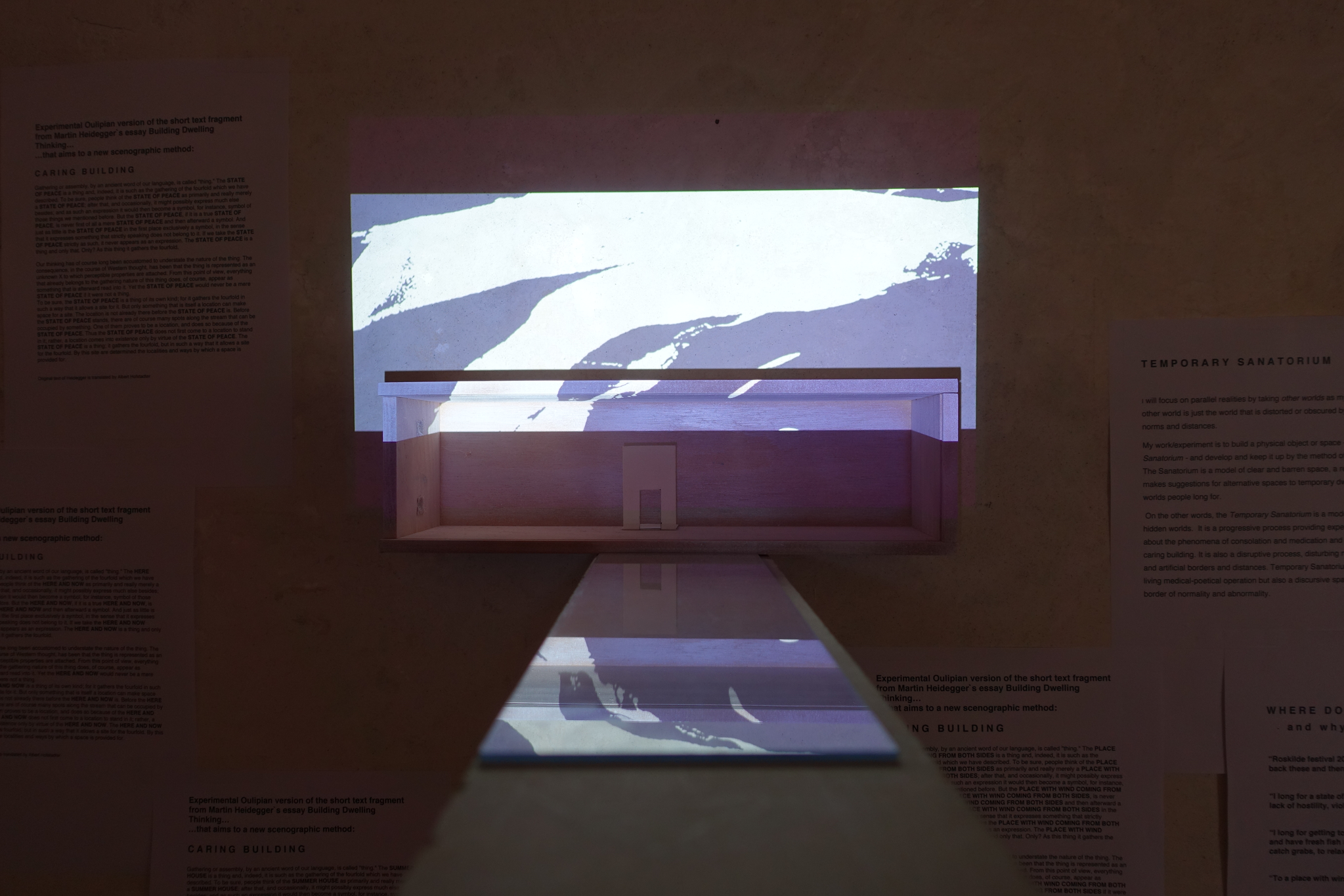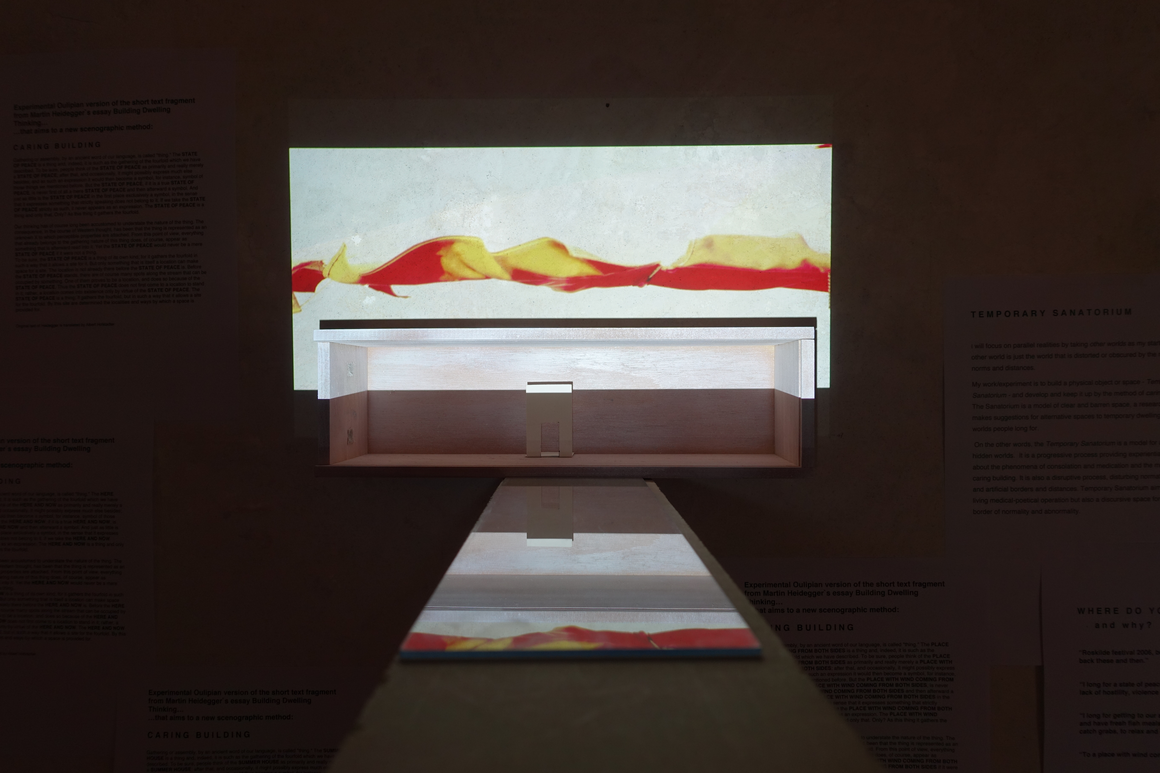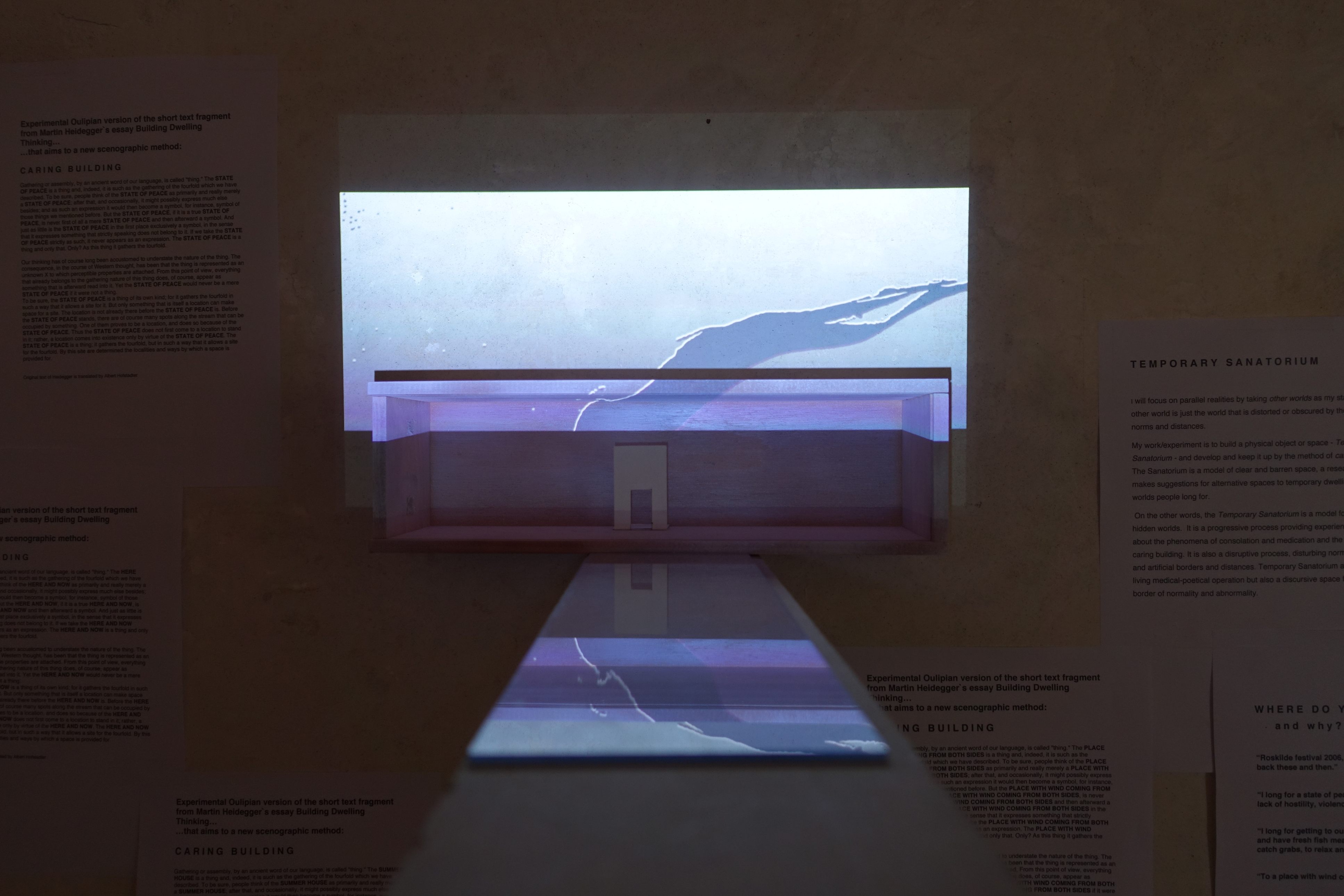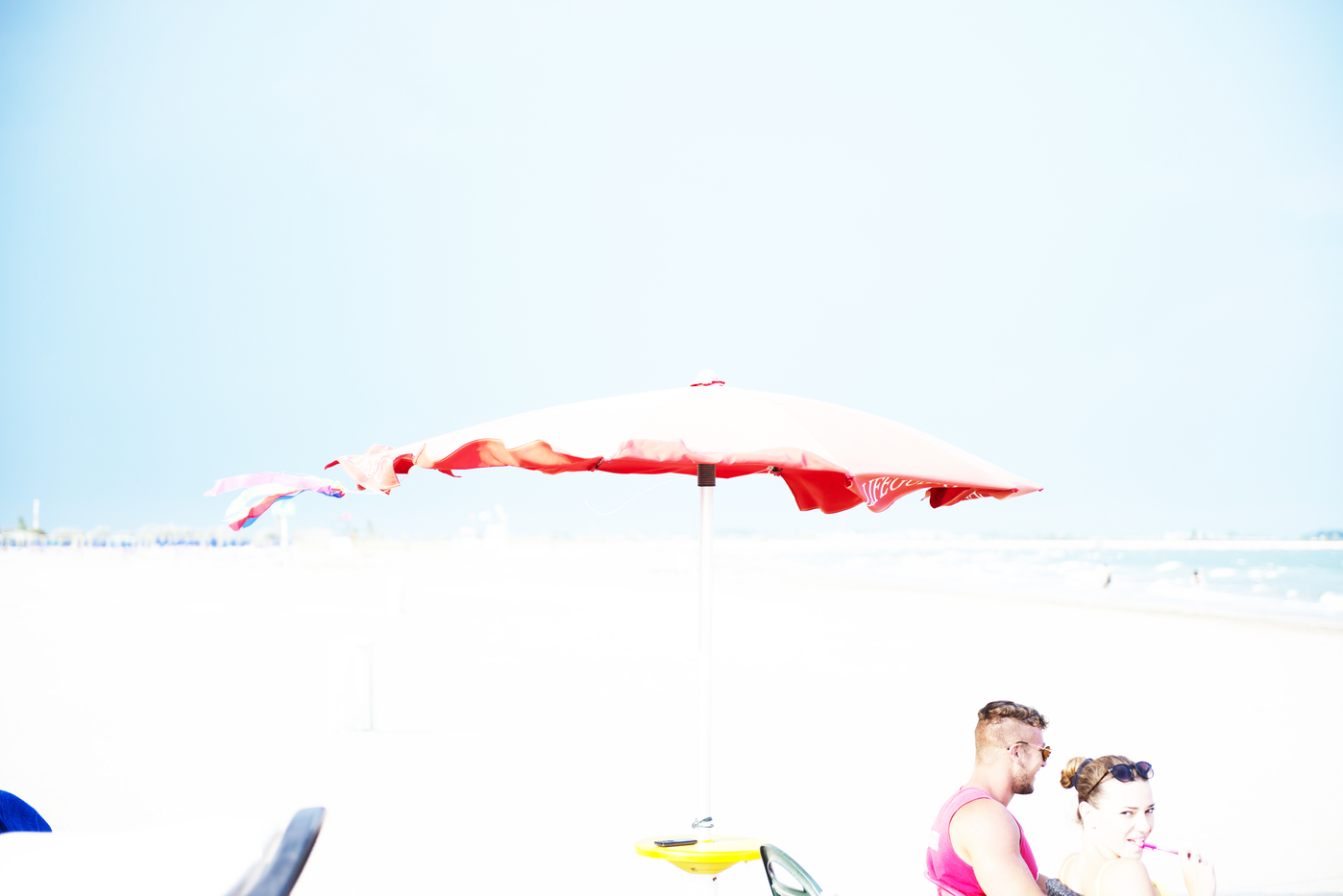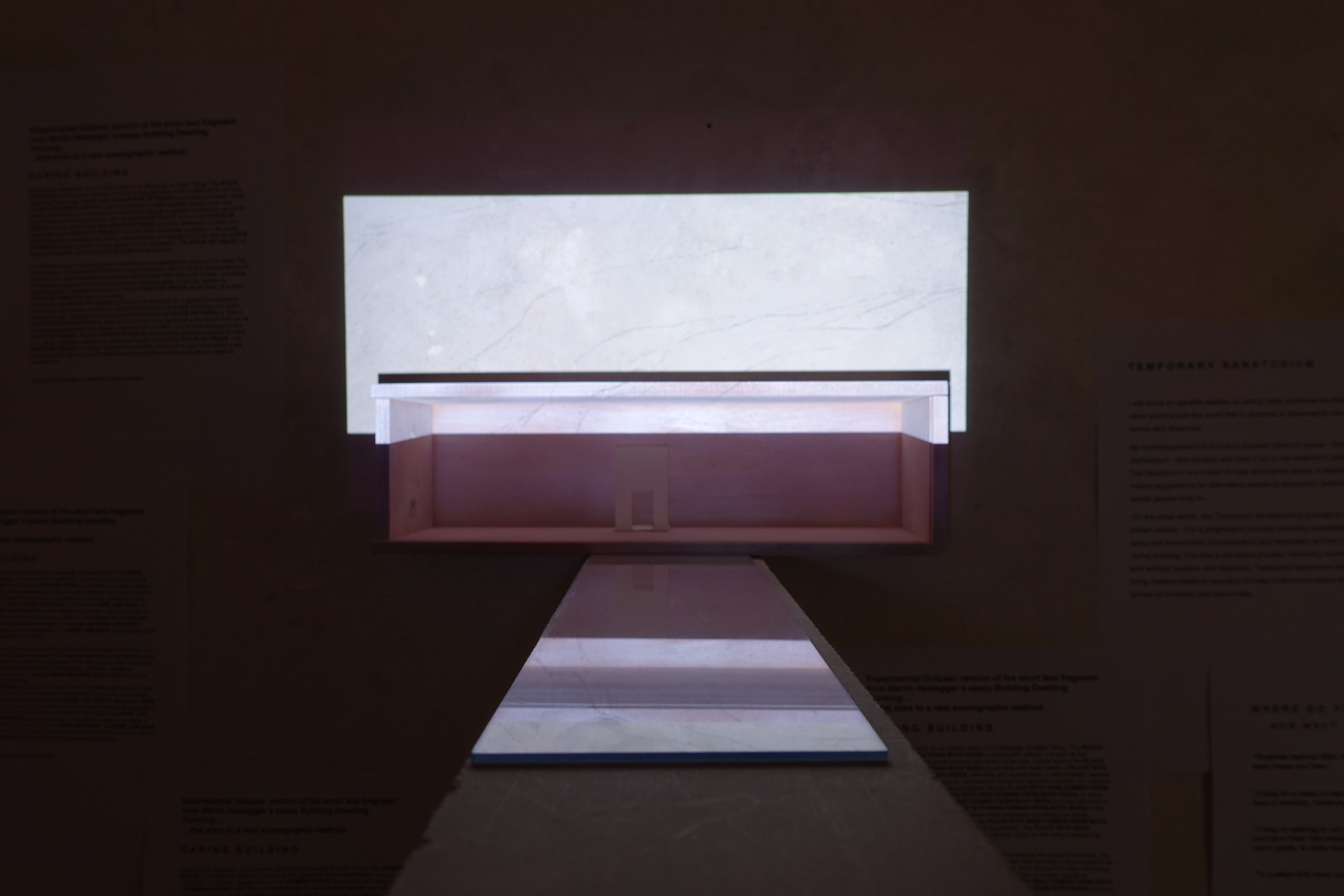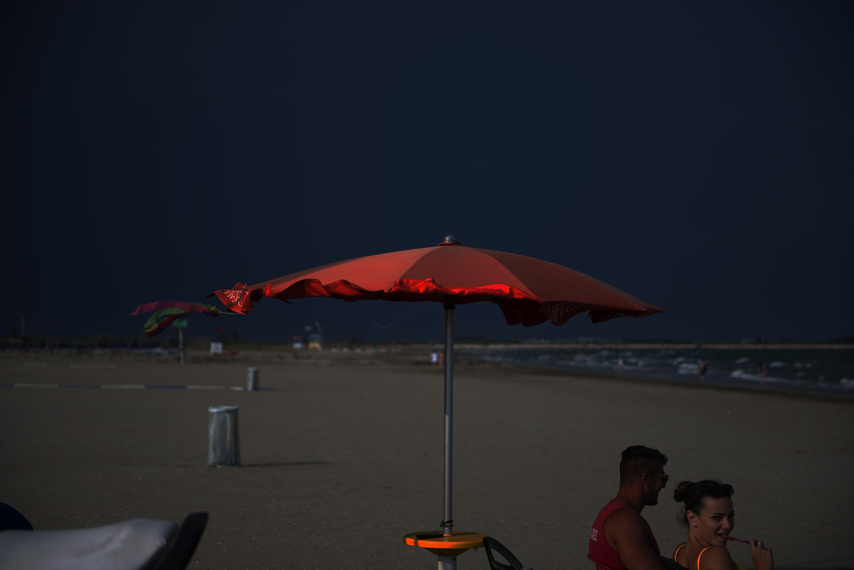F L O A T I N G P E R I P H E R I E S
Temporary Sanatorium is a part of the wider ongoing research project, Floating Peripheries – Mediating the Sense of Place (2017 -2019) , Aalto University, Department of Film, Television and Scenography & Department of Art: Liisa Ikonen, Maiju Loukola, Elina Lifländer, Harri Laakso & Pia Euro, researchers and artists, to whom peripheries means a wide range of spatial, conceptual and experiential phenomena and issues that usually receive less attention and discussion in our society.
Genius loci is a concept that comes from ancient Romans, who believed that everyone and everything in the world has its own guarding spirit.
L I V E D S P A C E
I approach this multidimensional abnormal space phenomenon via the thought of living. I think of abnormal space on the one hand as spatial and materialized circumstances, but at the same time as an identity-attached and an identity-creating environment. Living is always also a bodily event and the most private abnormal space is the body. Philosopher Jean-Luc Nancy has said that the body is a place for existing. This natural place of existence is transformed into an abnormal space when an intruder, a disease, enters it, and the body is exposed to an encounter with unfamiliarity. In the case of a person afflicted by memory sickness, the abnormal space-time opens up as a different experience of the present moment. The abnormal space-time conception of a person afflicted by memory sickness allows that person to return to time in the past and to be simultaneously elsewhere in addition to his/her own immediate location. This is something that is possible only in that particular abnormal space-time. I do not think of abnormal space as something negative or positive, but rather as a different observation position, a place producing a different kind of being in the world.
Abnormal space, thus, determines the distance and relationship to what is considered to be normal or natural. Abnormal space is a space where being something else, absence or lack of something are emphasized. It is always in relation to the body and it is sensed via the senses. I look at the abnormal space as an experienced or lived space in the manner expressed by Henry Lefebvre. In this way the immaterial, experience-based dimension is also always attached to the abnormal space: personal meanings, and memories, but also fantasies and imaginings, i.e. other worlds, which are distances away.
T E M P O R A R Y S A N A T O R I U M
Scenographer Liisa Ikonen
O T H E R W O R L D S A B N O R M A L S P A C E S A B N O R M A L S T A T E S
I have focused on parallel realities in my artistic research and its experiments by taking other worlds as my starting point. For me they are worlds that obscures by the real world`s norms or physical distances. I am exploring relationships of other worlds and parallel realities to phenomena I call as abnormal spaces and/or abnormal states.
In here, I mean by normal prerequisites for a good life from the individual`s point on view. In the like manner, by abnormal I mean deviations from that. By abnormal space, I mean space that is outside of normal, stabile forms of life and outside spaces belonging to good everyday life. It is a space that is shown or one that spills over, as it were, to society's underprivileged, various marginal groups, the sick and the abnormal of our society. Alternatively, it can also be a space that these groups take over or take for themselves spontaneously.
The abnormal space may be located somewhere outside, behind, away, off, down etc., either in private or institutional contexts. It may be located in hospitals, prisons, insulation centers or refugee camps. Abnormal space or abnormal state are always defined as distance or absence, but they can also be invisibly present in our immediate environment. It may be a social space or the bodily abnormal space that manifests itself in the sensorially-challenged person's different experience of the environment. Thus, an abnormal space may be either clearly visible or hidden and seeking to conceal itself. Abnormal state is a different way of observing this jointly shared world, and an abnormal space can be just an absence from the perceptible world.
P E R I P H E R I E S A N D C E N T E R S
An abnormal space can be said to be located in the periphery and peripheries exist only in relation to the centers that they have drawn away from. The boundary lines between peripheries and centers (or normal and abnormal) may be either clear and un-surmountable or porous and difficult to perceive. In one of his essays Of Other Spaces the French philosopher Michail Focault calls multifunctional spatial deviations heterotopies. According to Focault, heterotopias are the spaces that arise, inter alia, in the context of various crises and exceptional circumstances. They are kinds of spatial nodes in which a variety of spaces and spatial times or material cycles networks with each other.
My interest in abnormal space and its habitation means an interest in the whole of this network, especially in its points of intersection, in the porous relationship between diverse worlds (like between abnormals and normals), and in the way in which their spaces may become rebuilt and be inspired by each other. I am interested in the physical environments formed of places, but also in the spirit of places, genius loci, or lack thereof, which makes these places relevant and unfamiliar to their residents and users. The spirit of a place can be thought to be related to the emotional value and to how people feel about a place and how they do in it. It affects our way of being in places.
However, the abnormal space I am exploring belongs to the periphery, the periphery having no lustre or appeal to it. It is not that periphery that one can get to or the periphery that one seeks from one's own desire. It is the periphery where one ends up in.
C A R I N G B U I L D I N G
The German philosopher Martin Heidegger wrote poetically about humans' being in the world by using the word 'dwelling'. He has presented his views on the relationship between building, dwelling and thinking in his 1951 paper 'Building, Dwelling, Thinking' (Bauen Wohnen Denken). According to this Heidegger dwelling also includes the idea of building something and our task is to find the right kind of relationship to the place each of us lives in. However, 'building' here is not only limited to the building of houses or structures; it also has the meaning of the way in which we implement our dwelling, i.e. being. It also means building, which is implemented as caring, taking care of, protecting, and preserving - staying close to something. Keeping in close proximity is the reverse of placing oneself at the periphery, and particular to placing at the periphery, where the world is divided into two parts, this and the other and where is the distance in between.
Could new kind of caring building help us to think and implement an abnormal space in a new way? Could it help people to find the right sort of relationship to the place they live in. If I compare the idea of distance in between to Focault's idea of a heterotopy as a node, I find myself confronted by a web-like number of links to innumerable spaces, locations and functions, and to temporal layers to which abnormal space extends. The boundary lines begin to grow fuzzy. Could caring building be looking for, listening to and making visible the layers linking and concealing normal and abnormal.
Q U E S T I O N S
My phenomenologically oriented question is: What is an abnormal space and what is the surrounding network that intertwines this and the other worlds, and how do they manifest themselves? My artistic question is: How can I make them visible and to be experienced? But I am also asking as a phenomenologically excited artist-researcher: Can new, mutually modifying or boundaries-shifting interaction arise between abnormal and normal spaces? I ask: Can caring building enable a space that heals? Can a space recover itself and can it be medicated?
R E F E R E N C E S S I T A T I O N S T R A N S L A T I O N S
The abnormal space and abnormal state manifests themselves to me strongly as an issue between absence and presence or distance and proximity. As my research progresses, I will endeavour to develop such spatial and scenographic methods as will communicate especially these qualities. The starting points for these methods are the scenographic reference, scenographic sitation, and scenographic translation. The reference is not any old or ordinary reference in this context; instead, it is a specific spatial reference, the citation is a spatial citation, and the translation is translation into a space or from a space. I will be seeking to understand what the limits and opportunities of these methods are. I ask: What do these methods reveal about themselves as methods when working with them in artistic processes and at the same time I ask: How does the expression created using them help to bring peripheries and centers or this and the other worlds closer to each other.
Where do you long for?
- 'To a place, where the wind is coming both sides, any time any now'.
- W I N D, North east coast of Lido Venice, 19.6. at 18.11.55
- E S S E N C E O F W I N D, an experiment of scenographic reference in Temporary Sanatorium, in Giudecca Research Pavilion.
T E M P O R A R Y S A N A T O R I U M
As part of Artistic and Intelligent Research Alternator (AIRA project), I build a physical object or a mini-space Temporary Sanatorium, and my aim was to build and kept it up by the method of caring building. It was a small-scale research tool that invites people to temporary dwelling with their own dreams and fictions. With this experiment I called out forgotten worlds, worlds people long for, or worlds that have forbidden, and I 'built' a draft of temporary space that was colored by care.
I thought the Temporary Sanatorium as a meeting point for absence or hidden worlds. I was interested in searching experiential knowledge about the phenomena of spatial consolation and medication, and the method of caring building. I also wanted to disturb normative thinking and artificial borders and distances by my experiment. I also aimed to create a discursive space for the porous border of reality and its parallels, normality and abnormality. - Can new, mutually modifying or boundaries-shifting interaction arise between abnormal and normal spaces? Can some absent phenomenon that is distorted by distance i.e. that has become more or less fictional to become as a part of present moment and a real space.
The basis of my experiment was in the fundamental spatiality and temporality of man; the ability to understand space and time, both the present and the absent, but always experience it from the present moment. Also fiction and other worlds are experienced and understood always from the real world, here and now. Because the scenography is an art from the present moment, the absent temporality always manifests through some transformation. This is always the case, regardless of whether the space is visible and perceptible as such, here and now, or somewhere else, by citation, reference or translation.
